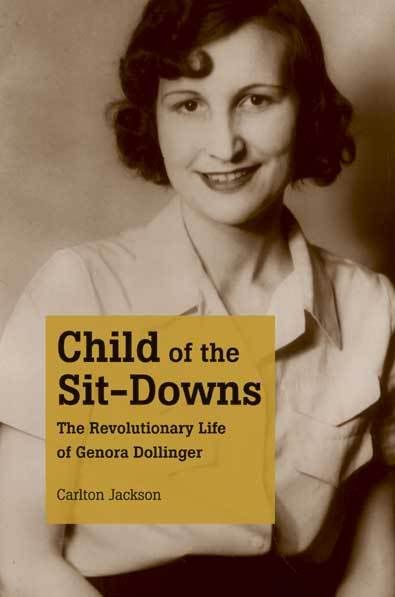Child of the Sit-Downs: The Revolutionary Life of Genora Dollinger, by Carlton Jackson, WKU Distinguished Professor Emeritus of History. Kent, OH: The Kent State University Press, 2008. 256 pages, $39.00 (cloth).

Herself a factory worker during the 40s, Genora once refused a front desk position (her good looks and charming demeanor occasioned the offer) so that she could work on an equal footing with other women and men. In general, women factory workers during the war years were not equal to men. A common misconception today is that women went into the factories out of a sense of patriotic duty. They were, in fact, more likely to be there from economic need. And they were frequently abused by male workers who felt they were taking jobs away from their male family members. The women were taunted, given the most menial and demanding of jobs.
In this atmosphere, Genora, aided by her second husband, Sol Dollinger, took up the union cause. Once she and Sol were beaten in their home, a beating that was assumed to be the work of anti-union goons. She did not give up. There were family problems: problems with her young sons, her conservative father. Genora persevered. She worked with the NAACP and the ACLU, and for various women’s causes.
Dr. Jackson says his objectives for writing this biography were comprehensive in nature:
l. To discuss unionism in the l930s (especially l937) and show its relationship to a rising feminism, as exemplified by the creation of the Women’s Emergency Brigade during the sit-down strikes against General Motors in Flint, Michigan.
2. To describe unionism and women’s work during World War II and how these two movements supported each other.
3. To examine the postwar attacks on unionism and the growth of governmental strictures because of the Cold War with the Soviet Union.
4. To explore the decline of the socialist groups throughout the country and explain why they declined.
5. To explain the growth of a generation gap between older and younger unionists and discuss why Genora Dollinger and her followers believed there was a need to revitalize radical unionism. This theme is most apparent in Genora’s railings against tuxedo unionism.
6. To offer some explanations of why mainline historians tended to bypass union and feminist participants like Genora Dollinger and of how things began to turn around in this respect by the l970s.
7. To illustrate some of the disagreements among women’s groups, particularly second-wave and third-wave feminists.
Wow! This book accomplishes all of the above and more. Jackson has a particular gift for studding his work with all kinds of facts and figures and doing that in such a way that facts and figures never seem heavy or heavy-handed. He has a lively, energetic style that keeps the narrative flowing.
He writes, “. . .the government, corporations, and even labor unions tried to put women back into their kitchens after the war. But women would have none of it; they had had a taste of freedom, independence, and self-esteem, and they meant to keep it.”
That is correct, of course, for so many women, and Genora Dollinger’s brave and tireless efforts for women workers’ cause and all movements that served the cause of fairness are of immeasurable worth. Many of those efforts have been unheralded for the past twenty years. Dr. Jackson’s wonderful book fixes that.
Reviewed by Mary Ellen Miller, WKU English Department. First published in the Daily News, Bowling Green, KY 42101.
|
| Print
